Question: Why would anyone attend a Megachurch? It just seems to be about hype and money and the pastor promoting himself. That’s not what church should be about.
I never expected to become an apologist for the Megachurch when I began my research years ago, but I’ve been shocked by the extent to which people say such negative — sometimes outright mean — things about megachurches. Just say the word “Megachurch” and watch the disgust on people’s faces.
To answer the question of why people go to megachurches we might begin by recognizing that a megachurch is formally defined by nothing but the size of the church. Sociologists define a megachurch as any church that has over 2,000 regular attenders. Given that our largest megachurches have well over 10,000 people (larger than most cities in America), the threshold doesn’t seem so high. But even at that level, there are only about 1,800 megachurches in the United States. In a universe of over 300,000 Christian churches, that less than half of 1% of all churches in America.
So we find that while megachurches are few, they command an extraordinary amount of attention. Even more, the fact that a church is large does not automatically tell us a lot. It’s denomination, it’s organization, it’s culture, or — important for this question — what types of people are attending.
One of the largest megachurches I’ve ever attended was a conservative Lutheran Megachurch in St. Louis, one that had a big building and ample parking. But the style of the church did not conform to the stereotypes held by many people about what “all megachurches” are like. Another big church in Hudson, Ohio I visited added a different nuance: the same building held two different styles of church services every Sunday simultaneously. One had organ, pulpit, and pews, with formally dressed ushers in blue blazers; the other had a praise band, no pulpit (not even a lectern), and moveable chairs, with casually dressed ushers in khaki pants and polo shirts. These entrance of these two contrasting services were located less than 20 yards from each other.
Once we get a sense of how varied and multiply-structured megachurches are, it becomes much less relevant to ask why people attend megachurches and more important to ask who goes to THIS megachurch, how the church started, what ministries of the church have been developed over time, how various groups connect to the ministries made available, and the way people define their involvement in this church. This only begins to get at why people attend the church. And by following up on such research in a range of megachurches (by denomination, by region, by date of founding), then we can get a sense of dominant structures of connection and involvement in various megachurches.

